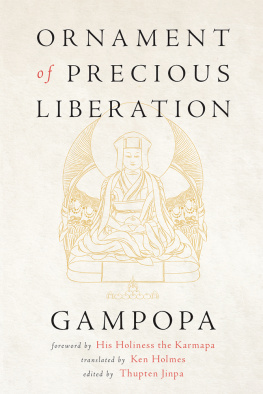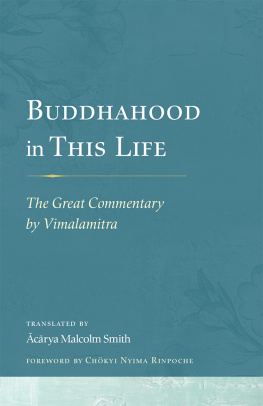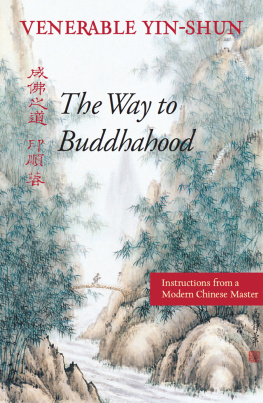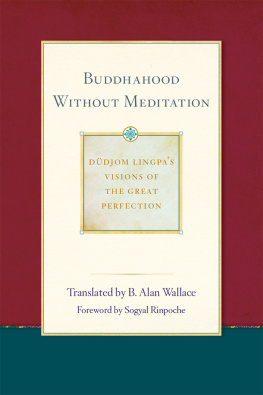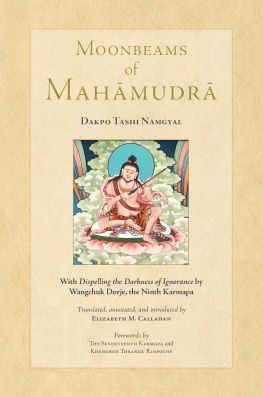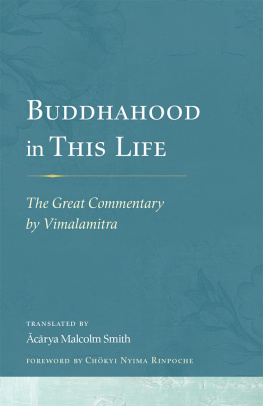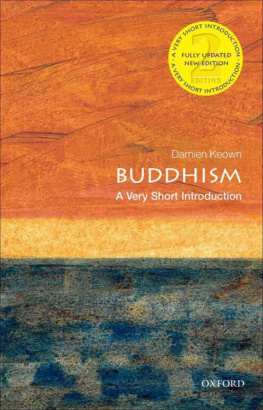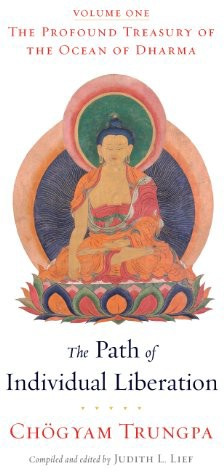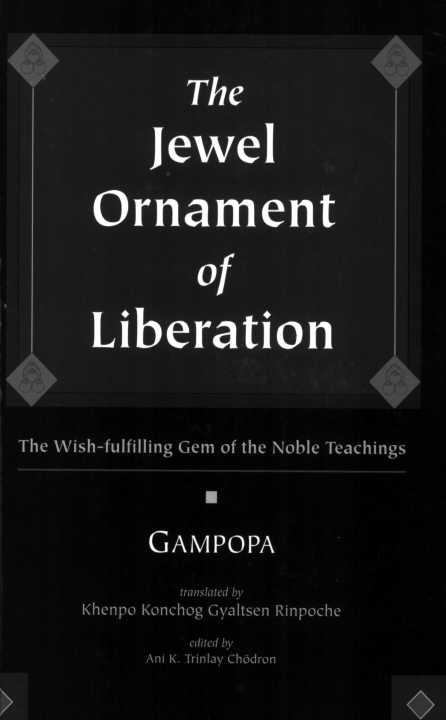
THE JEWEL ORNAMENT
OF LIBERATION
The Wish fulfilling Gem
of the Noble Teachings
THE JEWEL ORNAMENT
OF LIBERATION
The Wish fulfilling Gem
of the Noble Teachings
by
Gampopa
translated by
Khenpo Konchog Gyaltsen Rinpoche
edited by
Ani K. Trinlay Chodron

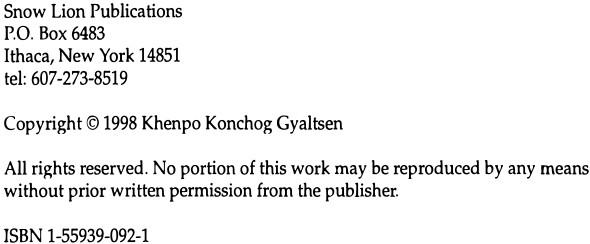
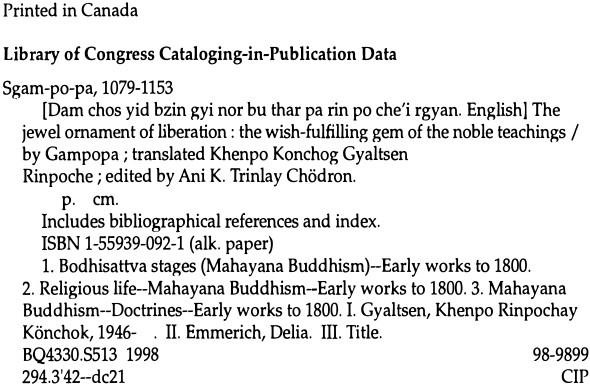

Table of Contents
Chapter 1: 49
Chapter 2: 59
Chapter 3: 69
Chapter 4: 83
Chapter 5: 95
Chapter 6: 111
Chapter 7: 125
Chapter 8: 137
Chapter 9: 147
Chapter 10: 173
Chapter 11: 179
Chapter 12: 183
Chapter 13: 195
Chapter 14: 205
Chapter 15: 213
Chapter 16: 219
Chapter 17: 233
Chapter 18: 257
Chapter 19: 263
Chapter 20: 281
Chapter 21: 297
Dedication
This book is dedicated to His Supreme Holiness, Tenzin Gyatso, the 14th Dalai Lama, the unparalleled earthly example of uncontrived outer and inner peace, and to my root lamas whose kindnesses are unrepayable.
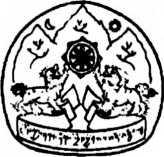
THE DALAI LAMA
Foreword
I am pleased to learn that the Drikung Kagyu Tibetan Meditation Center is publishing an English version of Gampopa's Jewel Ornament of Liberation. Gampopa is also known by the name Dakpo Lhaje-"The Physician from Dakpo." Of all the disciples of Milarepa, the two most important were called "the sun and the moon," and Gampopa was the sun disciple. He was a great, kind-hearted teacher and a practitioner of vast learning and discipline. This text is an excellent work that reflects the blending of two systems of teaching-the Kadampa tradition and the Mahamudra tradition. Gampopa received complete transmissions of Jowo Je's Lamrim tradition and Naropa's Mahamudra tradition. This text is therefore a Lamrim text and reflects the Madhyamika philosophical view, but it also implicitly reflects the teachings of Annuttarayoga Tantra and Mahamudra. Mahamudra is not explained explicitly, however, as this is a sutric text and Mahamudra deals with the secret teachings of tantra.Since many Westerners are now taking keen interest in the teaching of the Buddha, the English version of this wonderful teaching is timely and I am sure that it will be of great help to English readers. I would like to remind the reader that it is not enough simply to know the meaning of the dharma-we must always make an effort to implement it in our day-to-day life and to sincerely follow the way of practice that Milarepa and Gampopa have shown us.June 10, 1996
Acknowledgments
We are sincerely grateful for all the causes and conditions that came about to allow this translation to be published. An endeavor of this depth could only have been accomplished with the kind and generous support of others. In particular, we would like to recognize the efforts of:- Members of the Drikung Kagyu Centers throughout the United States, for repeatedly reading the manuscript, suggesting improvements, and generally encouraging us to complete this project. We would especially like to thank Robin Adams for her compassionate financial support, and Steve Willing for his meticulous editing and proofreading.- Lama Gyursam Acharya who, as resident lama at the Tibetan Meditation Center, was helpful in so many ways.- The staff at Snow Lion Publications, for ensuring the successful publication of this and other books.May the virtue accumulated through this work, and that of all merits in all lifetimes, be the cause for the enlightenment of all sentient beings!Khenpo Konchog Gyaltsen Rinpoche Ani K. Trinlay Chodron July, 1997
Translator's Introduction
I pay homage to all the root and lineage lamas! Please grant your blessings to me And to all sentient beings!Dharma Lord Gampopa (1074-1153 c.E.), the author of The Jewel Ornament of Liberation, was fully accomplished in the teachings and practice of Buddhism, the philosophy taught by Shakyamuni Buddha circa 560 B.C.E. Gampopa studied the sutra system of training in the Kadampa lineage and obtained tantra training from the great saint Milarepa. Because he himself thus embodied the complete form of Buddhism, Lord Gampopa successfully established complete Buddhism in Tibet. His lineage of disciples pervaded the whole of Jambudvipa and became the crown jewel of all Buddhism.He completely dispelled the darkness of confusion and reconciled all misunderstanding between the sutra and tantra systems. This is why, among Milarepa's disciples, he was declared to be "like the sun." In reality, it was as if the Buddha himself had manifested again in human form. Therefore, Gampopa's teachings are recognized as being wholly pure and precious.Of the many important texts he wrote, The Jewel Ornament of Liberation is probably the most significant. Gampopa said, "For anyone who wishes to see me, studying The Jewel Ornament of Liberation and the Precious Garland of the Excellent Path is the same as meeting me." So, The Jewel Ornament of Liberation acts as Gampopa's regent in these times. In this book, you will find a complete form of Buddhism-right from the starting point, the ground where you enter into the path, until you achieve Buddhahood and manifest activities for the benefit of infinite sentient beings.The first English translation of this work was done by Professor Herbert Guenther in 1959. His dedication and initiative have made this text well known to Westerners, and many people have received great benefit from his generous efforts. I rejoice in and respect his wonderful work. Because of his translation, I was encouraged by many students to start teaching The Jewel Ornament of Liberation. During the classes, I translated directly from the Tibetan into my simple English, while getting support for difficult passages from Professor Guenther's book. In this way, it took us about two and a half years to go through the text together. Many students expressed how much benefit they received from this uncomplicated presentation. So, with the idea that others might also benefit, we decided to publish this translation.So you readers don't have to consult so many different sources, translations of the life story of Dharma Lord Gampopa and the stories referred to in the text are also included here. They are from the Bendurya Tratsom, compiled by the Venerable Khenpo Lodro Donyo, one of my best friends during my school years. His book is very helpful when you study The Jewel Ornament of Liberation because it fills in all the gaps.In the seventh, eighth, tenth, eleventh, and twelfth centuries in Tibet, many enlightened translators rendered Buddhism into Tibetan from Sanskrit. The Buddhist texts we currently have in Tibetan can be translated almost exactly back into Sanskrit without losing any of the original meaning. This was possible because the Tibetan language is very rich and parallels Sanskrit quite well. In addition, they were able to translate and retranslate texts many times.There were three basic styles of translation in those days: literal, for meaning, and both literal and meaning combined. Most great translators made the effort to translate the literal text and the meaning together. We made every effort here to translate in this way, but due to the limitations of the English language, as well as the very profound meaning of the Dharma, this translation can still be improved in the future.The jewel Ornament of Liberation is one of the books that I cherish most. I had the great good fortune to receive this precious teaching from the acclaimed master Khunu Lama Rinpoche, Tenzin Gyaltshen. I received Vajrayana teachings, including the Fivefold Path of Mahamudra, from the eminent retreat master Khyunga Rinpoche during my three-year retreat. From the enlightened retreat master Pachung Rinpoche, I received the Six Yogas of Naropa, Mahamudra, and many other instructions and transmissions.Khunu Lama Rinpoche was born in northern India. He was a consummate scholar of Sanskrit. In addition, he went to Tibet and studied with many eminent teachers from the different schools, gaining understanding in all aspects of knowledge, both conventional and absolute. Later, he fully dedicated his life to retreat, renouncing all worldly concerns in order to embody the teachings he had studied. Since studying with him, I myself have made efforts to understand this book. I have given teachings on it to monks in different monasteries on several occasions, and even to Western Dharma-students.Many hundreds of years have passed, lifestyles and cultures have changed, but pure Buddhism-the teachings about suffering and the cause of suffering, happiness, peace, and their causes-does not change. Even though this book was written in Tibet in the eleventh century, it remains relevant to the twenty-first century Western world, with its highly developed material and scientific technologies. I find that Gampopa's wisdom accords very well with modern scientific theories.Gampopa based his text on Atisha's Lamp for the Path to Enlightenment. Khunu Lama Rinpoche said that this was the first Lam Rim' text written in Tibet and that all the later, great Lam Rim texts were based on The Jewel Ornament of Liberation. Therefore, all the different Buddhist schools in Tibet study it. This is a critically important text to study as a foundation for the traditional three-year retreat.The twenty-one chapters in this book systematically lay out the path that must be traveled to reach Buddhahood-no more, no less. If you miss one step, the goal cannot be achieved. More is not needed; the route is complete. This book is a pith instruction, not an extensive commentary, not with hidden meaning-just precise and consistent teachings. Everyone who is interested in Buddhism can study this and apply it in their practice. If you study this text thoroughly, you will gain an understanding of the complete form of the stages of Buddhism. Don't expect to understand everything just by reading it once or twice. As His Holiness the Dalai Lama emphasizes, it is best to rely on an authentic teacher and to practice in order to understand the full depth of this great work. SYNOPSIS PART 1: THE PRIMARY CAUSE
Next page

